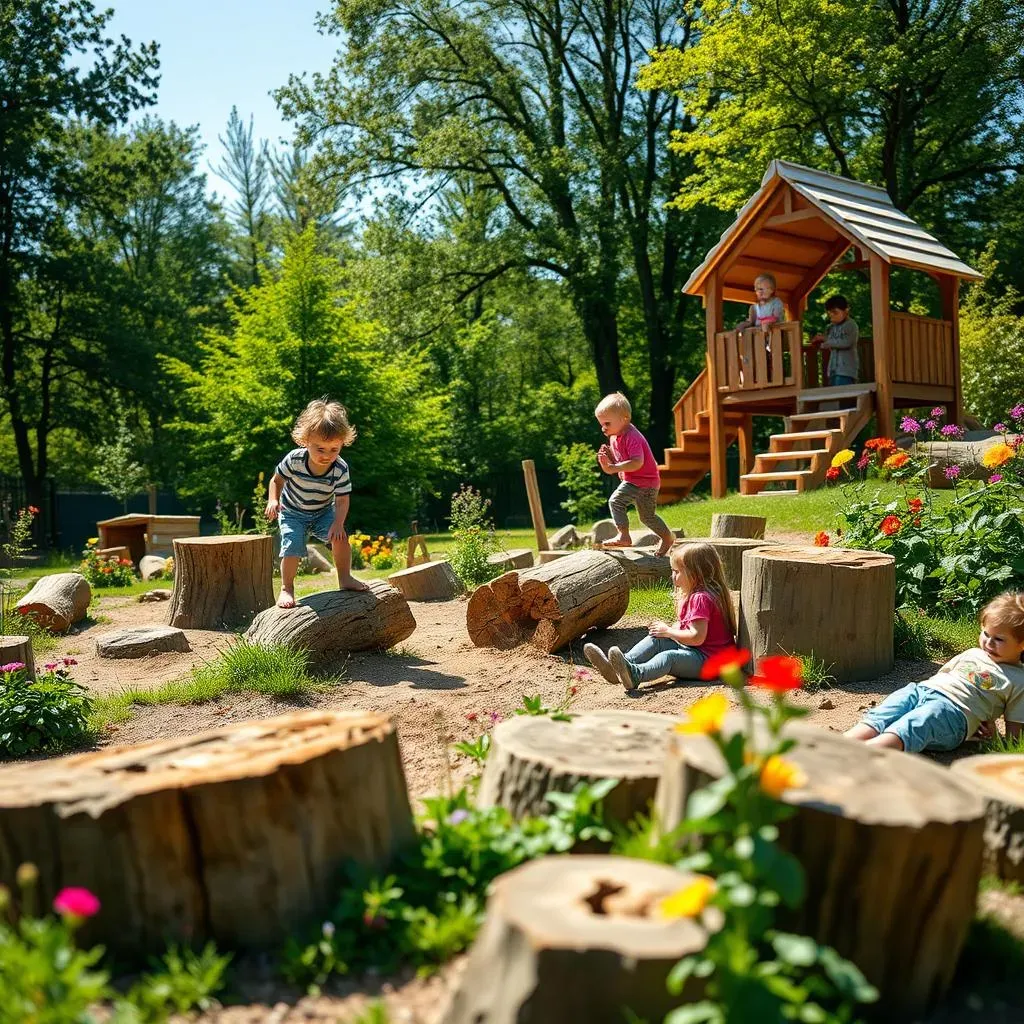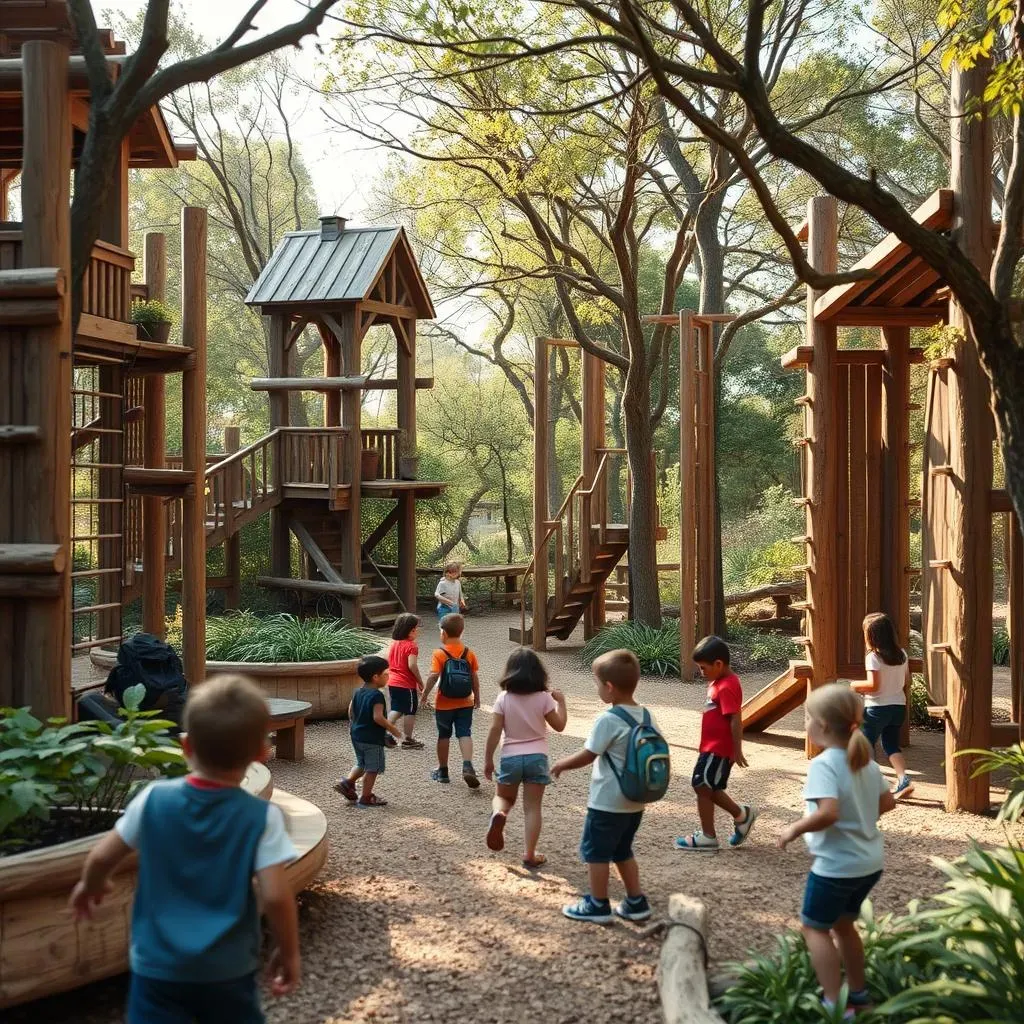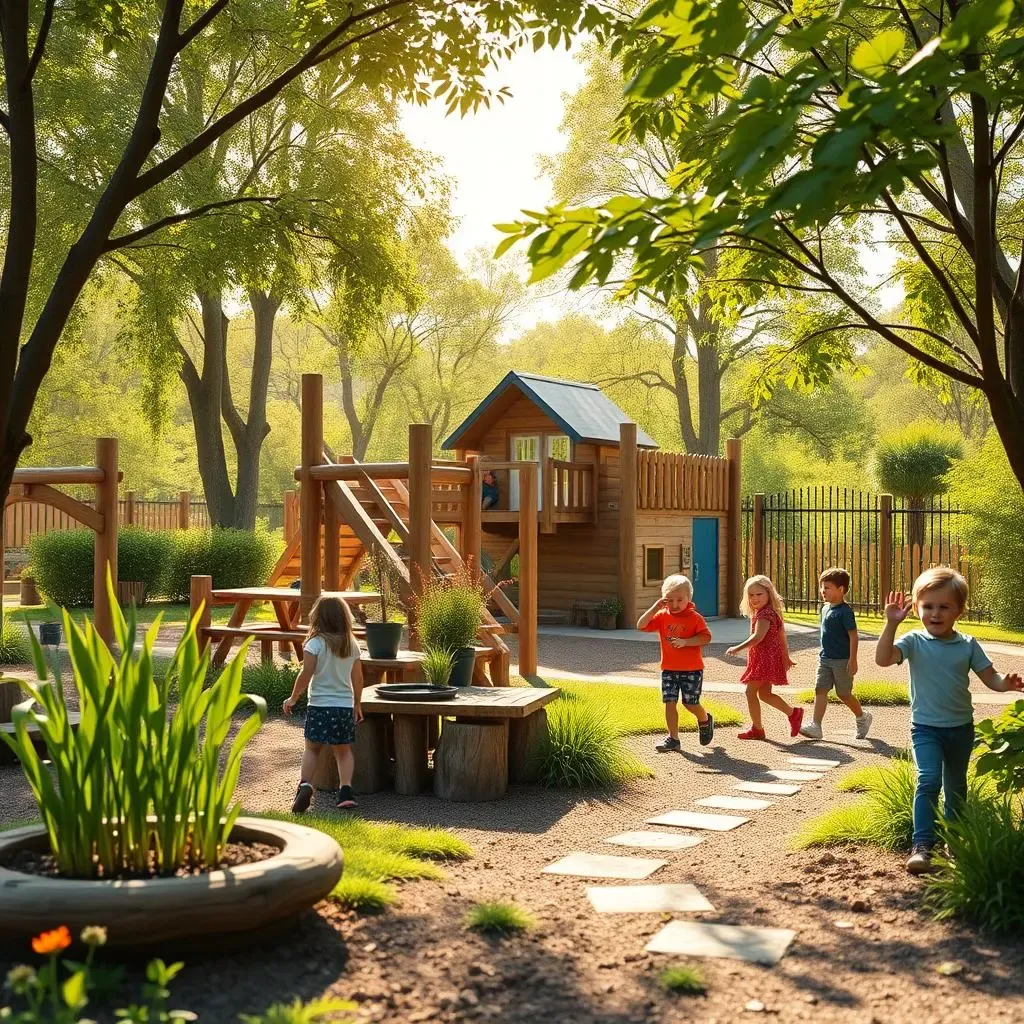Table of Contents
Are you ready to revolutionize playtime at your school? Forget the same old, rusty metal jungle gyms! This article dives into the exciting world of natural playground equipment for schools. We'll explore the incredible benefits these innovative play spaces offer – from boosting kids' physical health and cognitive development to fostering a deeper connection with nature. Get ready to learn how natural playgrounds enhance creativity, problem-solving skills, and social interaction. We'll guide you through the process of designing and building your own unique natural playground, helping you select the perfect equipment to fit your school's needs and budget. We’ll also cover the importance of maintenance to keep your natural playground safe and engaging for years to come. By the end, you'll be equipped with the knowledge to transform your schoolyard into a vibrant, enriching, and naturally inspiring learning environment. So, let's create a playground where learning and fun grow together!
Benefits of Natural Playground Equipment for Schools

Benefits of Natural Playground Equipment for Schools
Enhanced Physical Development
Natural playgrounds are amazing for kids' physical growth! Think climbing over logs, balancing on tree stumps, and navigating uneven terrain. These activities build strength, coordination, and balance far better than standard playground equipment. It's like a natural gym, constantly challenging their bodies in new and exciting ways. They develop gross motor skills, improving their agility and spatial awareness. This type of play is crucial for healthy development, reducing the risk of childhood obesity and promoting a lifelong love of physical activity.
Kids aren't just passively playing; they're actively engaging their muscles and senses. It's a dynamic, ever-changing environment that encourages exploration and challenges their bodies in ways that traditional equipment simply can't match. This active play is incredibly beneficial for their overall health and well-being.
Benefit | Description |
|---|---|
Improved Gross Motor Skills | Climbing, balancing, and running on natural surfaces enhances coordination and agility. |
Increased Strength and Endurance | Overcoming natural obstacles builds muscle strength and improves cardiovascular health. |
Reduced Risk of Injury | Softer surfaces and varied play options minimize the risk of falls and other common playground injuries. |
Cognitive and Creative Stimulation
Forget pre-packaged play! Natural playgrounds ignite children's imaginations. They become architects of their own adventures, building forts from branches, creating obstacle courses, and inventing games using the natural materials around them. This fosters problem-solving skills, creativity, and independent thinking. It's not just about following instructions; it's about designing and executing their own play experiences. They learn to assess risk, collaborate with peers, and adapt to changing circumstances, all while having a blast.
The open-ended nature of natural play encourages experimentation and innovation. There are no set rules or prescribed ways to play; children are free to explore their creativity and develop their own unique play styles. This fosters a sense of ownership and empowers them to take initiative. This kind of imaginative play is essential for cognitive development, and builds crucial skills for future success.
- Improved Problem-Solving Skills
- Enhanced Creativity and Imagination
- Increased Independence and Self-Confidence
Connection with Nature and Environmental Stewardship
Natural playgrounds aren't just about play; they're about fostering a love for the natural world. Kids connect with nature directly, experiencing its textures, sounds, and smells firsthand. They learn about different plants, insects, and animals, developing an appreciation for biodiversity and environmental responsibility. It's a powerful way to teach children the importance of protecting our planet and understanding their place within the ecosystem.
Playing outdoors in a natural environment helps children develop a deeper understanding and respect for nature. They learn about the interconnectedness of living things and the importance of conservation. This connection can inspire a lifelong commitment to environmental stewardship and responsible citizenship. It’s a powerful lesson that goes far beyond the playground.
Designing and Building Your School's Natural Playground

Designing and Building Your School's Natural Playground
Planning Your Natural Playground
Before you even think about digging, grab a pencil and paper (or fire up your favorite design program!). Start by assessing your school's existing outdoor space. What are its dimensions? What kind of soil do you have? Are there any existing trees or other natural features you can incorporate? Consider the age range of the children who will be using the playground. This will help you determine appropriate challenges and features. Think about incorporating different zones for various activities – a climbing area, a sandpit, a quiet area for imaginative play, perhaps even a small mud kitchen! Remember, safety is paramount. You'll want to ensure there's enough space between equipment, and that the surface is soft and absorbent to minimize the risk of injuries.
Involve your students! Ask them what kind of playground they'd like. Their input will not only make the design process more fun, but it will also guarantee they'll love the final product. Think about accessibility. Make sure all children, regardless of their abilities, can participate. Consider using ramps instead of stairs, and ensuring there's enough space for wheelchairs or other mobility aids. You might even want to consult with landscape architects or playground designers for professional advice and guidance, especially for larger projects.
Planning Stage | Action Items |
|---|---|
Site Assessment | Measure the space, note existing features, assess soil type. |
Needs Analysis | Consider age range, desired activities, and accessibility requirements. |
Design Development | Sketch out different zones, incorporate student input, and prioritize safety. |
Sourcing Materials and Construction
Now for the fun part – gathering your materials! Natural playgrounds are all about using what nature provides. Think about sourcing reclaimed wood from local demolition sites, or using sustainably harvested lumber. Branches, logs, stones, and even sand can be incorporated into your design. If you need to purchase materials, look for suppliers who prioritize sustainability and ethical sourcing. Remember, you want durable and safe materials that can withstand the elements and the enthusiastic play of children. For example, pressure-treated wood is a popular choice for its durability and resistance to rot. You'll also need tools – shovels, saws, hammers, and maybe even a digger for larger projects. Consider involving local contractors or community volunteers to help with the construction process. It's a great way to foster community engagement and make the project even more meaningful.
Construction can be a collaborative effort, involving teachers, students, parents, and community volunteers. This shared experience builds a sense of ownership and pride in the playground. Remember to always prioritize safety. Ensure that all materials are properly secured and that the playground meets safety standards. Regular maintenance will be essential to ensure the playground remains safe and enjoyable for years to come. This might involve replacing damaged wood, replenishing sand, and ensuring all structures remain stable. Regular inspections by qualified professionals are advisable, especially for more complex playground designs.
- Source reclaimed or sustainably harvested wood.
- Gather natural materials like stones, branches, and sand.
- Utilize local contractors or community volunteers for construction.
- Prioritize safety and adhere to relevant building codes.
Choosing the Right Natural Playground Equipment for Schools

Choosing the Right Natural Playground Equipment for Schools
Balancing Risk and Reward: Assessing Age Appropriateness
Choosing the right equipment is crucial for a safe and engaging natural playground. Consider the age range of the children who'll be using it. Toddlers need different challenges than older kids. For younger children, focus on low-to-the-ground features like sandpits, small climbing logs, and gentle slopes. These offer opportunities for exploration and development without significant risk of injury. As children get older, introduce more challenging elements like taller climbing structures, rope swings, and balance beams. Remember, the goal is to provide a stimulating environment that encourages physical activity and skill development while minimizing potential hazards. Always supervise young children closely, especially in areas with potential risks.
Think about the different developmental stages. Younger children are still refining their gross motor skills, so they need simpler, less challenging equipment. Older children, on the other hand, are ready for more complex activities that push their physical and cognitive limits. The equipment should offer a range of challenges, allowing children to progress at their own pace. This ensures that everyone has a fun and engaging experience. Regularly assess the equipment and make adjustments as children grow and their skills improve. You want to ensure the playground continues to be stimulating and appropriate for their age and abilities.
Age Group | Suitable Equipment |
|---|---|
Toddlers (2-3 years) | Sandpits, low climbing logs, gentle slopes, small slides |
Preschoolers (3-5 years) | Slightly taller climbing structures, simple balance beams, small tunnels |
Older Children (5-12 years) | Taller climbing structures, rope swings, balance beams, more complex obstacle courses |
Material Matters: Durability and Sustainability
When selecting materials, prioritize durability and sustainability. Reclaimed wood is an excellent choice; it's environmentally friendly and often more affordable than new lumber. Ensure the wood is treated to prevent rot and insect infestation. Natural materials like stones and logs should be carefully selected to ensure they're stable and safe. Avoid using materials that could splinter easily or present other hazards. Consider the local climate and choose materials that can withstand the elements. For example, in areas with heavy rainfall, you might need to select wood that is particularly resistant to moisture damage. Regular maintenance will be essential to keep the playground in good condition and prevent accidents.
Sustainability should be a key consideration. Look for materials that are sourced responsibly and have minimal environmental impact. Consider using locally sourced materials to reduce transportation costs and emissions. Choose materials that are long-lasting and require minimal maintenance to reduce waste and the need for frequent replacements. Educate students about the importance of sustainability and encourage them to care for the playground. This could involve regular clean-up activities or participation in environmental projects. The playground itself can become a living classroom, teaching children about responsible environmental stewardship.
Maintaining and Enhancing Your Natural Playground Equipment for Schools

Maintaining and Enhancing Your Natural Playground Equipment for Schools
Regular Maintenance and Safety Checks
Think of your natural playground as a living, breathing organism – it needs regular care to thrive! Just like any other playground, regular maintenance is key to ensuring safety and longevity. This means regular inspections for loose screws, broken parts, or rotting wood. Address any issues promptly to prevent accidents. Regularly check the surface materials, ensuring they're still soft and absorbent enough to cushion falls. Replenish sand or wood chips as needed to maintain adequate depth. Trim overgrown branches or plants that could pose a hazard. Think of it as a preventative maintenance program; catching small issues early prevents larger, more costly problems down the line. A well-maintained playground is a safe playground.
Involve your students in the maintenance process! They can help with tasks like raking leaves, picking up litter, and reporting any damaged equipment. This fosters a sense of responsibility and ownership, ensuring the playground remains a shared resource that everyone cares for. Consider creating a playground maintenance schedule, assigning tasks to different classes or groups of students. Make it a fun and engaging activity, turning maintenance into a learning opportunity. You might even create a reward system for students who consistently contribute to keeping the playground clean and safe. Regular maintenance is not just about safety; it's about creating a sense of community and shared responsibility.
Maintenance Task | Frequency |
|---|---|
Inspect for loose parts or damaged equipment | Weekly |
Check surface materials (sand, wood chips) | Monthly |
Trim overgrown vegetation | As needed |
Major repairs or replacements | Annually |
Enhancing the Play Experience
Once you've established a solid maintenance routine, it's time to think about enhancements! Natural playgrounds are dynamic; they should evolve and change over time. Consider adding new features to keep the play experience fresh and engaging. Introduce new climbing structures, build a mud kitchen, or create a nature trail. Incorporate seasonal elements; pumpkins in the fall, pinwheels in the spring. These additions not only keep children engaged, but they also encourage creativity and exploration. Regularly rotate or add new elements to maintain interest and prevent boredom. This keeps the playground feeling new and exciting, encouraging children to return and explore again and again.
Remember to involve students in the decision-making process when choosing enhancements. Ask them what they'd like to see added to the playground. Their input will ensure the playground remains relevant and engaging for them. Consider creating a suggestion box or holding regular meetings to gather ideas. This collaborative approach fosters a sense of ownership and pride, making the playground a truly shared space. You might even create a rotating display of student artwork or nature-themed projects to add a personal touch. Remember, a playground is more than just equipment; it's a reflection of the community it serves.
- Add new climbing structures or obstacle courses.
- Create a nature trail or sensory garden.
- Build a mud kitchen or water play area.
- Incorporate seasonal decorations or features.